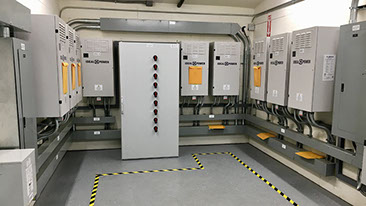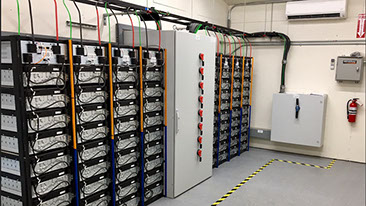Nestled in a wooded community is a microgrid that defies the usual value propositions. It’s an outlier of a project because microgrids are normally built for different reasons, such as to bring power in developing countries to people who depend on unreliable or non-existent grid infrastructure, or to save on delivering expensive diesel fuel to islands or other remote locations, or to save on corporate energy costs – to mention a few.
So why is this microgrid here? It represents an interesting choice in the diverse and growing portfolio of energy options by its owner. He wanted to substantially upgrade his electric service, but he also wanted to reduce his carbon emissions. This microgrid project represented a unique solution to reduce levelized cost of energy based on the various capital and expense requirements. This microgrid represents a private investment by someone who is attracted to energy innovation and the desire to explore the boundaries of affordable and proven contemporary technology.
What Does a Private Microgrid Look Like?
In order to create the ultimate personal microgrid, you could start – as this microgrid investor did – with land, multiple buildings, a significant power demand and energy consumption, and a need for charging electric vehicles.
This is exactly the setup that we encountered when approached by the Owner’s Agent for the property owner. This was an unusual request but a great challenge and a very interesting project. We are used to designing solar-storage microgrids for privately owned islands in the Caribbean, but we welcomed the challenge of the different climate, soil conditions, load profile, and solar resource.
We modeled the microgrid system and performance characteristics using HOMER Pro from HOMER Energy. That made it easy to analyze and communicate the performance of the project, clearly portray some of its complex engineering features and benefits to the client, while selling the merits of our approach.
Engineering started in the spring of 2017, construction began in October of 2017, and this microgrid became fully operational in the summer of 2018. It includes a new 4,160 VAC distribution system on the property (the original distribution system was a split-phase 120/240 VAC grid more typical for residential neighborhoods).
The new private medium-voltage grid was engineered to reduce losses resulting from distributing high power levels across the large site. We elected to do it at medium voltage to reduce the line losses, and also in this case to reduce the construction costs. The medium voltage allowed us to use the existing conduit and avoid any more excavation in the rocky ground that would have been necessary for lower voltage runs with bigger cables. This is a common technique we use for private Caribbean island projects. Typically the construction cost is a bit higher, but the energy savings over time make it a significant net-positive outcome.
The project includes a 300 kW fixed-tilt PV array, 650 kWh of lithium-ion batteries, two banks of bi-directional converters (BDC’s) in a DC-coupled architecture, and two engine-generator sets (gensets) that are sized to run 30% of the time. The sizing and configuration of these energy resources were based on the HOMER Pro modeling, which calculates the annual and lifetime Levelized Cost of Energy (or LCOE), based on asset capital cost and ongoing operating expenses. The HOMER model creates an hour-by-hour simulation model of the project, based on the expected load profile, local climate data, and incorporating variability in these system drivers to simulate real-world conditions.


Dispatch of the batteries, which can supply backup power for about a day, are managed by the microgrid site controller. The site controller starts discharging batteries in the late afternoon when the solar array stops producing. This is a typical microgrid operational profile, whether in a northern latitude or in the Caribbean.
The microgrid equipment is installed in a dedicated power house. The power house was designed and constructed by the Owner based on the specifications to house the equipment and support the project. The building has abundant interior space for expansion, and climate control for the microgrid equipment, as well as small UPS to power the site controller in the event of a black-start condition. We always includes a small UPS, based on previous projects that have been left “in the dark” without being able to power up.
How to Design a Microgrid – Energy Efficiency First
Before adding new renewable resources on the property, the team worked hard to improve energy efficiency. The Owner implemented a variety of energy efficiency measures to reduce power and energy demands.
In order to economically optimize a project like, it’s crucial to wring maximum benefits out of energy efficiency improvements. Despite its status as the least glamorous of energy upgrades, energy efficiency provides the best return on investment. Lopata says, “Some energy efficiency always makes sense, because you are reducing your operating expenses, often with little capital investment and sometimes with only no-cost operational changes. This can drive paybacks as short as 1-2 years or even immediate positive cashflow. But if you’re building a microgrid, efficiency is an even better idea because you can reduce the size of the microgrid as well as your capital investments in energy generation resources.” For instance, simply turning off a hundred incandescent light bulbs that are left on during the day will save the energy produced by 25-30 kW of solar PV capacity and eliminate the need for 75-100 kWh of battery storage, reducing the overall project cost by $75k to $125k. If there ever was a “no-brainer”, smart energy efficiency is it!
HOMER Model versus Real Performance
As part of the initial goal-setting exercise, a “design charette” if you will, we used HOMER Pro to model the overall energy plant to deliver the LCOE option. That typically results in the generators running about 30% of the time. The gensets overall are operating around 25% of the time, demonstrating that the microgrid does indeed work as engineered.
The solar system is performing so well that the inverters are curtailing some of the power in the summer. This happens in every microgrid when you design for the LCOE performance target. At times the generating capacity will exceed the load when the batteries are fully charged.
The cost of solar and storage equipment is coming down over time, and the efficiency and performance are improving. Microgrid will continue to become more economical, and it is possible for private individuals to invest in energy systems that would have been utterly impractical in the past. Some of the systems we engineer deliver reductions in the cost of electricity of over 50%, and have paybacks less than 5 years. The Internal Rate of Return (IRR) can be in the double digits, depending on the cost of fossil-fuel generation and other factors.
However, even though solar and microgrids will be lower cost and deliver higher investment performance in the future, in cases where energy costs are high, it is almost always more economical to build the clean-energy systems now rather than wait. We have another article here that outlines the financial benefits of building solar now rather than waiting.
